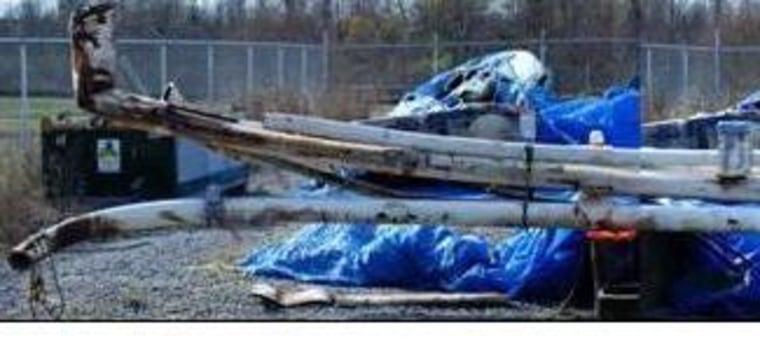The shutoff device that should have stopped the BP oil spill failed largely because of a faulty design and a trapped piece of pipe, an official probe found Wednesday. The report appears to shift some blame for the blowout from the oil giant and toward the companies that built and maintained the 300-ton safety device.
The 551-page report said the piece of drill pipe prevented the blowout preventer's blind shear rams, or BSRs, from sealing the well around the time of the April 20 oil rig explosion off the coast of Louisiana. The shear rams are components in a blowout preventer that cut, or shear, through drill pipe and form a seal against well pressure.
"The primary cause of failure was identified as the BSRs failing to fully close and seal due to a portion of drill pipe trapped between the blocks," the report stated.
The drill pipe's position within the wellbore caused it to buckle and bow when the well lost control, impeding the rams, according to the report.
Det Norske Veritas, the Norwegian firm hired by the government to test the blowout preventer, also faulted the performance and design of the failsafe device.
The report doesn't single out any one party involved in the well, but discusses in great detail why the device didn't work. The device was made by Cameron and maintained by Transocean Ltd.
In response to the report, Cameron spokeswoman Rhonda Barnat said the blowout preventer "was designed and tested to industry standards and customer specifications." She added, "We continue to work with the industry to ensure safe operations."
In a statement, Transocean said the findings "confirm that the BOP was in proper operating condition and functioned as designed." It added: "High-pressure flow from the well created conditions that exceeded the scope of BOP's design parameters."
BP spokesman Daren Beaudo said the oil company supports efforts by regulators and the industry to make blowout preventers more reliable.
Speculation on why the blowout preventer failed has persisted during the year since the disaster.
Documents emerged early in the probe showing that a part of the device had a hydraulic leak, which would have reduced its effectiveness, and that a passive "deadman" trigger had a low, perhaps even dead, battery.
DNV noted loss of fluid and weak battery issues in its report, but did not seem to cite them as significant causes of the blowout preventer's failure.
Philip Johnson, a University of Alabama civil engineering professor, said the report indicates that the blowout preventer had a design flaw in its blind shear rams that may have gone unnoticed by the entire industry, not just by Cameron.
"This is the first time in all of this that there has been a clear design flaw in the blowout preventer cited," he said. "My reaction is, 'Holy smokes, every set of blind shear rams out there may have this problem.' We need to take a look at every set of blind shear rams out there and make sure they all don't have this problem."
"There are plenty of lawyers out there that are going to try to make this Cameron's fault, but I couldn't help (the lawyers)," he added.
The firm made several recommendations for the industry in its report, including changing the design of blowout preventers.
The firm's tests also indicated that some back-up control system components did not perform as intended. It recommended the industry revise its procedures for periodic testing and verification of the back-up control systems to assure they will function properly at all times.
Blowout preventers sit at the wellhead of exploratory wells and are supposed to lock in place to prevent a spill in case of an explosion.
The device that was used with BP's Macondo well was raised from the seafloor Sept 4. Testing began at a NASA facility in New Orleans in November.
Representatives for Cameron and Transocean were among an army of interested parties that were allowed to monitor DNV's examination of the device. BP, the Justice Department and lawyers for plaintiffs in lawsuits over the disaster also were allowed to monitor. None of them was allowed to have any hands-on involvement.
The official testing ended earlier this month. BP has asked a federal judge for permission to conduct additional testing on its own. Cameron has objected, saying that if further testing is done, a neutral third-party should do it.
An investigation into what caused the rig explosion and oil spill is being overseen by a joint U.S. Coast Guard-Bureau of Ocean Energy Management Regulation and Enforcement panel. While DNV's report was largely limited to results of its blowout preventer testing, the government panel is scheduled to release a final report over the summer assigning blame for the disaster.
Ervin Gonzalez, a Miami attorney who is one of the lead plaintiffs' lawyers in the federal litigation spawned by the spill, said BP was ultimately responsible for ensuring that equipment on the rig was adequate and properly maintained.
"They can't shake that off by blaming other parties," he said. "They should have known the equipment was insufficient to maintain well control. We shouldn't be finding this out now. They should have known this before."
